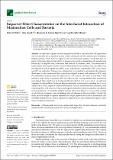| dc.contributor.author | Baby, Helna M. | |
| dc.contributor.author | Joseph, John | |
| dc.contributor.author | Suresh, Maneesha K. | |
| dc.contributor.author | Biswas, Raja | |
| dc.contributor.author | Menon, Deepthy | |
| dc.date.accessioned | 2023-12-22T15:38:54Z | |
| dc.date.available | 2023-12-22T15:38:54Z | |
| dc.date.issued | 2023-10-07 | |
| dc.identifier.uri | https://hdl.handle.net/1721.1/153236 | |
| dc.description.abstract | An imperative requisite of tissue-engineered scaffolds is to promote host cell regeneration and concomitantly thwart microbial growth. Antibacterial agents are often added to prevent implant-related infections, which, however, aggravates the risk of bacterial resistance. For the first time, we report a fiber-based platform that selectively promotes the growth of mammalian cells and alleviates bacteria by varying fiber size, orientation, and material of polymeric yarns. The interactions of Gram-positive and -negative bacterial species with mammalian mesenchymal stem cells (MSC) were investigated on poly-€-caprolactone (PCL) yarns, polyethylene terephthalate (PET), poly-L-lactic acid (PLLA), and cotton. Various yarn configurations were studied by altering the fiber diameter (from nano- to microscale) and fiber orientations (aligned, twisted, and random) of PCL yarns. PCL nanofibrous yarn decreased the adhesion of <i>S. aureus</i> and <i>E. coli</i>, with a 2.7-fold and 1.5-fold reduction, respectively, compared to PCL microfibrous yarn. Among different fiber orientations, nanoaligned fibers resulted in an 8-fold and 30-fold reduction of <i>S. aureus</i> and <i>E. coli</i> adhesion compared to random fibers. Moreover, aligned orientation was superior in retarding the <i>S. aureus</i> adhesion by 14-fold compared to nanotwisted fibers. Our data demonstrate that polymeric yarns comprising fibers with nanoscale features and aligned orientation promote mammalian cell adhesion and spreading and concomitantly mitigate bacterial interaction. Moreover, we unveil the wicking of cells through polymeric yarns, facilitating early cell adhesion in fibrous scaffolds. Overall, this study provides insight to engineer scaffolds that couple superior interaction of mammalian cells with high-strength fibrous yarns for regenerative applications devoid of antibacterial agents or other surface modification strategies. | en_US |
| dc.publisher | Multidisciplinary Digital Publishing Institute | en_US |
| dc.relation.isversionof | http://dx.doi.org/10.3390/applbiosci2040033 | en_US |
| dc.rights | Creative Commons Attribution | en_US |
| dc.rights.uri | https://creativecommons.org/licenses/by/4.0/ | en_US |
| dc.source | Multidisciplinary Digital Publishing Institute | en_US |
| dc.title | Impact of Fiber Characteristics on the Interfacial Interaction of Mammalian Cells and Bacteria | en_US |
| dc.type | Article | en_US |
| dc.identifier.citation | Applied Biosciences 2 (4): 527-541 (2023) | en_US |
| dc.contributor.department | Massachusetts Institute of Technology. Center for Biomedical Engineering | |
| dc.identifier.mitlicense | PUBLISHER_CC | |
| dc.eprint.version | Final published version | en_US |
| dc.type.uri | http://purl.org/eprint/type/JournalArticle | en_US |
| eprint.status | http://purl.org/eprint/status/PeerReviewed | en_US |
| dc.date.updated | 2023-12-22T13:45:04Z | |
| dspace.date.submission | 2023-12-22T13:45:04Z | |
| mit.license | PUBLISHER_CC | |
| mit.metadata.status | Authority Work and Publication Information Needed | en_US |
